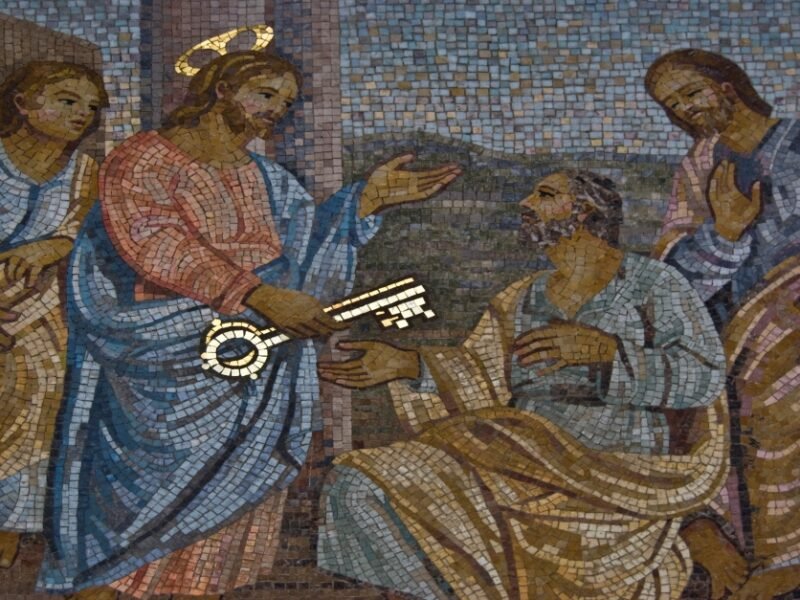Scanning through the documents pertaining to the Anglo-Prussian Bishopric of Jerusalem recently helped to focus my mind on what one might call the proto-ecumenical movement. The nineteenth century was an age of rampant denominationalism, but it also saw the first tentative moves toward ecumenicism. Unlike twentieth-century ecumenicism, which at times sounded like an exercise in wishful thinking, the attempts at greater Christian Unity made in the 19th and the early 20th century were more of an exercise in matching like with like. Whilst very little that was concrete was achieved, doors and minds were opened, and the union of the Church seemed less of an impossible dream.
The Prussian Union
The major example of this impulse towards union is the Prussian Evangelical State Church. Johann Sigismund of Brandenburg-Prussia had attempted a second Reformation within his lands in 1613-1617 following his own conversion to the Reformed faith, but his attempts to impose this on the Electorate, and on the Duchy of Prussia had failed. Lutheranism was too engrained in the hearts of ordinary Prussians to be easily removed, and moreover, the sort of Lutheranism practiced there was of a highly conservative type. The Elector had no choice but to allow a bi-confessional state with the aristocracy and the lower class remaining Lutheran, but the royal house and the bureaucracy and bourgeoisie being largely Reformed.[1] Later in the 17th century, and at intervals through the 18th century the idea was floated of creating a united Protestant (Evangelisch)[2] Church with the rulers of Prussia looking at the Church of England as a model.
In the end, it was Pietism, Romanticism, and the Royal Will that brought about the Union. As far back as the Colloquy of Thorn in 1645,[3] it had been agreed that the primary point of disagreement between Lutherans and German Reformed was the nature of Christ’s presence in the Eucharist. The Lutheran concept of sacramental union declared Christ to be present “in, with, and through” the bread and wine, whilst the Reformed held the concept of real, spiritual presence in which the believer received Christ’s body and blood spiritually when he received the body and blood physically. After the Thirty Years War, Pietism emerged as a major force in German religious life, and with its emphasis on inward religion, it tended to downplay the differences between confessions. Couple this with the fact that Reformed practice in Brandenburg-Prussia was moderate, so that the differences of practice between them and the Lutherans were less marked than elsewhere, and all it needed was a pathway for resolving the differences.
The first serious attempt occurred in 1710-1714 when Daniel Ernst Jablonski[4] initiated a correspondence with Archbishop Tenison, then with Archbishop Sharp about a union between the Church of England and a unified Prussian Evangelical Church. Friedrich I was clearly interested in the Book of Common Prayer and the Articles of Religion as a way of drawing his Lutheran and Reformed subjects together. To this end, a German edition of the 1662 Book of Common Prayer was prepared and was used for a time in the royal chapel. However, the correspondence was conducted against the background of the War of the Spanish Succession, so although the clerics were enthusiastic, the politicians were otherwise occupied, and the deaths of Friedrich I of Prussia in 1713 and of Queen Anne in 1714, with the consequent accession of Georg Ludwig of Hanover as George I, seem to have put a permanent damper on the project. However, the idea did not totally disappear, and with good relations between England and Prussia being the rule rather than the exception throughout the 1700s, the idea of both a Union Church and a link to the Church of England reemerged a century later.
In the end, it took definite Royal action to cut the cackle and attempt a union. The course that Friedrich-Wilhelm III took was novel. After consulting with both the Lutheran and Reformed leadership, he did not try to resolve the differences up-front, but rather created a structure within which the two confessions could peacefully coexist within the State Church. The Prussian Union accepted – after Scripture – the Augsburg Confession, the Large and Small Catechisms of Martin Luther, and the Heidelberg Confession, as its symbols, and churches could choose to identify (sounds terrible Po-Mo, but hang in there!) as Lutheran, Reformed, or Evangelisch.
Most parishes and parishioners in the Prussian lands accepted the Union, but because of the coercive nature of Friedrich-Wilhelm’s religious policy after 1822 when he began to force a unified Liturgy[5] on the Church, dissent developed among the Old Lutherans, especially in Prussian Saxony and Silesia. However, these dissenting minorities[6] should not distract us from the fact that the Prussian Union was widely accepted. For example, by 1829 5,500 parishes out of 7,700 accepted the new Prussian Liturgy, and even more claimed to adhere to the Union. Furthermore, the Prussian Union was paralleled by similar moves in Hesse, Nassau, and several other smaller states. However, in these smaller states, there was much less conflict, and unity was rooted in the popular Pietism of the time. By the 1850s, the great majority of German Protestants belonged to one of the Evangelisch Union Churches, though certain parts of Germany, such as Hamburg, remained confessionally Lutheran and outside the Union.
The Anglo-Prussian Bishop of Jerusalem
This unionistic impulse found a concrete manifestation in the Anglo-Prussian Bishop of Jerusalem, which, although primarily a “CofE” entity, also gave oversight to Evangelisch congregations in Palestine, Egypt, Lebanon, and Syria. The union was based on a common understanding of Christianity which was neither wholly Reformed, nor wholly Lutheran, and in the case of the Anglicans was rooted in the Articles of Religion, and in the case of Evangelisch, the Augsburg Confession. Both Churches were liturgical, with the 1662 BCP being used by the Anglicans, and the 1822/29 Prussian Liturgy by the Evangelisch. The project limped along for 45 years until it fell victim to Anglican exclusivity and German Imperialism. It remains an interesting “what might have been” in terms of creating a multi-national Episcopal, “Evangelisch” Church.
In the United States, it seems to have been the Episcopal Church that thought about this issue the most. The figure most associated with these Evangelical stirrings is William Augustus Muhlenberg (1797-1877), an Episcopal priest of Lutheran ancestry who, although generally claimed by the Catholic wing of Episcopalianism in the twentieth century, was in fact an Evangelical Catholic. Much of his experimentation drew on contemporary Lutheran trends and ideas, rather than on the burgeoning Ritualist Movement in England. Muhlenberg also had a strong interest in the reunion of Evangelical Christians and presented a Memorial to the General Convention of 1856 which called for a loosening of episcopal exclusiveness to provide a focus of unity through episcopacy. The idea got referred to a committee, but it bore fruit in two ways.
Muhlenberg Memorial to Chicago-Lambeth Quadrilateral
The first was the Reformed Episcopal Church, founded in 1873. One avowed aim of the new REC was to be a focus of union for Evangelical Christians. The terms of subscription were relaxed so that the determining theological focus was “the doctrines of Grace as contained in the 39 Articles” and there was a definite repudiation of both Episcopalian exclusiveness and “Popery” via the Declaration of Principles. However, although the ecumenical focus of Muhlenberg, which was shared by Bishop Cummins, was a major impulse behind the creation of the REC, and it did bring in some folks of Methodist and Presbyterian backgrounds, in the end, it got lost in the internal wrangling between the Liberal, Fundamentalist, and Episcopalian factions within the new denomination. When the REC did at last find a strong identity for itself c.1900, it was as “Presbyterians with a Prayer Book” which remained the status quo until the late 1980s.
The Muhlenberg Memorial was not altogether forgotten in the Episcopal Church either, and many of Muhlenberg’s ideas were adopted by William Reed Huntington (1830-1909), who is the father of the Chicago-Lambeth Quadrilateral, which defined the core principles of the Church as the Bishop, the Apostles,’ and Nicene Creeds, the two sacraments, and the episcopate (locally adapted). Originally proposed at the Chicago General Convention of 1884, it was adopted in a modified form by the Lambeth Conference of 1888 as a basis for future ecumenicism. Huntington’s work also bore fruit in the form of Canons permitting congregations to join the PECUSA whilst retaining elements of their own liturgical tradition, allowing the ordination of non-episcopal ministers on what might be described as “easy terms,” and allowing episcopal priests to serve churches of other denominations. These ecumenical impulses can be seen in Canons 15 and 36 of the 1958 Canons of the PECUSA.[7]
Although these early ecumenical endeavors did not produce much fruit at the time, early twentieth-century mergers and reunions were often informed with the same “like-with-like” outlook. A natural merger was that of the moderate Reformed Church in the United States, whose confessional document was the Heidelberg Catechism, with the Evangelical Synod of North America, which had as its standards the Augsburg Confession, Luther’s two Catechisms, and the Heidelberg Catechism. The two denominations came together in 1934 as the Evangelical and Reformed Church. Two Methodist-influenced offshoots of the German Protestant tradition, the United Brethren and the Evangelical Association merged in 1946 to produce the Evangelical United Brethren, and so forth.
Unity Without “Mush”
This small-scale ecumenicism still has relevance today, even though the climate for church mergers is much cooler now than it was in the 1970s. Ecumenical initiatives between Roman Catholics and Protestants have stalled and Protestant ecumenicism became more about managing the decline than “sharing the vision” in the late-twentieth and twenty-first centuries. Liberal, “Anythingarian”[8] theology propels the “mush-merger” rather than seeking to merge with other bodies of similar faith and background. Arguably the first of these mush mergers was the 1957 merger of the Congregationalists with the Evangelical and Reformed Church which produced a body, the United Church of Christ, which was a testimony to both the depth of ecumenical commitment on the part of the leaders of both denominations, and their unrealistic appreciation of the cultural, theological, and liturgical differences between the churches.
However, despite the warnings of history conservative Christians, and especially traditional Anglicans, need to remain engaged in the search for unity, especially given that Anglicanism has been pulled by the centrifugal cultural forces of the twentieth century into three distinct strands which have more in common with those outside of Anglicanism than they do with other Anglicans. Ultimately, the future of Anglo-Catholicism lies with Orthodoxy or a reconstituted Old Catholicism because they have held to the reformed catholic identity within Anglicanism whilst rejecting its doctrinal Protestantism. The neo-Evangelicals ultimately have more in common with the Holiness and Pentecostal churches through the Convergence Movement than they do with wider Anglicanism because they share the same sort of spirituality, albeit in a moderated form. This leaves the Confessional Anglicans who share more in common with moderate Lutheran and Reformed Christians than they do the Anglo-Catholics and the Neo-Evangelicals.
Perhaps that Jerusalem Bishopric was not such a bad idea after all!
NOTES
- It is perhaps an interesting sidelight on the social conventions of 19th-century Prussia that when the Mendelssohn family were baptized in 1816, they joined the Reformed Church which befitted their bourgeois status. ↑
- Although the German word “Evangelisch” has much the same meaning as Protestant in English, I have chosen to leave it untranslated in the context of the Prussian Evangelical State Church, and the German Unionist Churches in general because they are not generic Protestant Churches but a functional union of Lutheran and Reformed Christians within a common structure and liturgy. ↑
- For the Colloquy of Thorn see Schaff’s The Creeds of Christendom, with History and Critical Notes, Volume I. ↑
- For a more detailed treatment of this subject see R. Barry Levis, “The Failure of the Anglican-Prussian Ecumenical Effort 1710-14” in Church History, Vol. 47, No. 4, pp.381‒399 (Dec. 1978) ↑
- The 1822 Prussian Liturgy, although drawn up by a king with a Reformed background, is of the Lutheran type standing in the Formula Missae tradition but is entirely in German. However, the king trod on some Lutheran toes by, for example, requiring the Unser Vater form of the Lord’s Prayer. A revision of the Liturgy in 1829 removed many of these objections, but the damage had already been done. ↑
- One element of the 19th-century immigration from Germany to America was “Old Lutherans” displaced by Friedrich-Wilhelm’s heavy-handed imposition of the Church Union and the 1822 Liturgy. The persecuted minority found their way to places like Missouri, Ohio, and Wisconsin where they founded new confessional Synods. ↑
- Canons 16 and 35 in the present UECNA code. ↑
- My thanks to Dean Jonathan Swift for this useful expression. ↑







'The Greater Church' have 7 comments
August 24, 2023 @ 1:43 pm Matthew J. Taylor
Excellent article!
How should the realigned Anglican bodies balance the pursuit of union with one another against union with Lutherans and non-English Reformed?
Should the first priority be finding terms in which the remaining independent Anglican bodies enter into the current ACNA ,or should the first priority be the creation of a new Ecclesia Americana into which the ACNA and other bodies would merge?
August 25, 2023 @ 8:14 am Peter David Robinson
ACNA is too “mushy” to be useful in this context until it sorts out which of the three to five identities it accommodates is its actual identity. Creating something new is going to be fraught with danger in the present theological and cultural context as the UCC paradigm for merger it too prevalent. Therefore, one is dependent on the various remnants working it out quietly away from the ‘big schemers’ which is something that is happening under the radar.
August 25, 2023 @ 3:51 pm PWH
Thank you for this fascinating study.
August 26, 2023 @ 10:36 am Columba Silouan
Is there a permanent place within the ACNA for Anglican Catholics? Is that place The Reformed Episcopal Church, The Missionary Diocese of All Saints, or can a new ACNA Diocese be formed to accommodate them? And by Anglican Catholic I also mean Anglican Orthodox, because some Anglican Catholics favor Eastern Orthodoxy above Rome.
August 26, 2023 @ 11:19 pm Greg
A very pertinent and wise question. Thank you.
August 28, 2023 @ 9:46 pm Fr. Isaac J. Rehberg
The Dioceses of Ft. Worth, Quincy, San Joaquin, and MDAS all have pretty solid reputations as Anglo-Catholic dioceses. And there are AC’s among the REC, though in general the REC tends to range from “classic BCP Anglicanism” to “Prayer Book Catholic.” MDAS is non-geographic, and some of the others have a few parishes far outside their boundaries. I doubt new affinity dioceses are likely, though. The general opinion is that we need to be moving away from affinity dioceses and towards geographic ones being the norm. That doesn’t preclude new church plants among existing affinity dioceses, of course.
November 4, 2023 @ 2:11 am Samuel
The third group, the confessional Anglicans, could in my opinion become the place in which the classical Protestants unite. If they deal with their\’e internal problems in the Anglican communion, they may very well do what Luther and Zwingli failed to do at Marburg (even if small schismatic bodies continue for a while)
Once that happens in a major enough country, an ecumenical council should be called, to settle on a unified creed on Justification and make decisions on whatever other controversies if the last millenia need addressing in an ecumenical council.